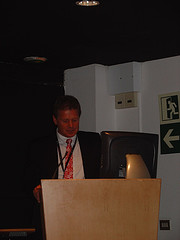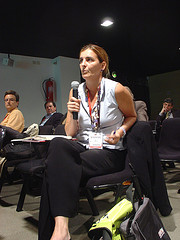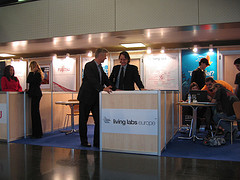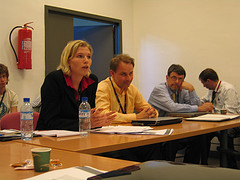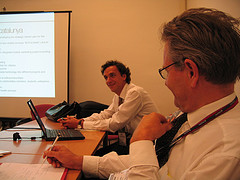mClusters Conference in Monaco April 18-20
Tuesday, April 24th, 2007Introduction by Prof. Jan Annerstedt, Living Labs Global / Interlace Invent
In the mobile & wireless industry, Europe sits on a very large source of technology, with huge potential. Thus, we need a release of this resource, involving both macro and micro economics aspect, including citizens, business and travellers.
The mClusters project, sponsored by Europe INNOVA, is tasked with connecting the European innovation environments, within mobile & wireless services and solutions.
One of the main questions is whether we can actually shape innovation environments, and whether Europe is open enough to do this? The mClusters projects have so far looked at and benchmarked 21 European cities, on both hard & soft factors, to understand this dynamic, and one of the outcomes of the project is to support European cities in these endeavours to promote new models for innovation environments fostering user-driven innovation in the mobile & wireless areas, as well as to create a leading network of cities for mobile innovation.
Some of the conclusions so far: A city such as Tallinn, can be very effective in achieving excellence in new business ventures within the mobile & wireless industry, and use the networks of European innovation cities, to export the innovative solutions to other areas of Europe. Thus, the open innovation environments, or ‘Living Labs’ can help foster excellence in the innovation and commercialisation of mobile & wireless solutions, and as such work as a platform for attracting capital and talent to a region, as a mode of collaboration, and to involve users in the design and development processes. Hence, the Living Lab becomes a city-based innovation resource taking advantage of regional pools of creative talent, the affluence of cultural diversity, and unique regional resources.
One of the questions from the audience was how do you become a Living Lab? One of answers is that the driving force behind a living lab is the drive of business and users, to actively strive for pioneering mobile & wireless services and solutions in the context of a city-area, with the participation of universities, public administration, firms, users and citizens, and actively create links between the user groups. Thus, becoming a living lab is as much a question about management capacity and drive, as about set methodologies.
Jens Bley, Director Living Labs Germany, Partner Content Bridge AG
Living Labs Germany today is a network organisation, focusing on ICT and mobile & wireless services. In Hamburg, these activities have been pioneered by close collaboration with the industrial organisation of ICT companies, with the main focus on content and content-based services.
The two pioneering projects out of Hamburg, but with nationwide impact are Mobile Marketing in Urban Spaces and mTourism.
In the Mobile Marketing in Urban Spaces the urban commercial communication space is combined with mobile & wireless services. Consequently, the city has been broken into local entities, to develop the relationships with local stakeholders and thus provide a platform for developing city-wide services based on local engagement and business models. Public media provides navigation, communication and several other services, which can be enhanced by the mobile phone in the urban and mobile space.
One of the main focus areas is the urban furniture in Hamburg, in which outdoor advertising contracts in Hamburg have been tendered out, with the purpose of leveraging the multimedia aspects of the city. Although the main part of the business on urban furniture is done via traditional advertising, the future will be based on mobile and interactive services, which suddenly introduce new players to the market.
The public medium raises awareness, and the mobile phone raises the recall rate. Consequently, the business models are not new, but a known currency in the media and marketing world is being employed in a new business area. Hence, a variety of pioneering application are being developed in areas such as storefinder, live casting, event offerings, discount-coupons, public information, live voting, and interactive quizzing. For the consumers, the drivers are navigation, entertainment and smart shopping, for the marketers this is about traditional business drivers such as marketing, drivers of communication and awareness.
In the mTourism area, Living Labs Germany is taking advantages of the links to Living Labs Stockholm, signing an agreement to prototype the mobile tourism solutions developed and in use in Stockholm, in the cities and tourism destinations in Germany. This is combined with new initiatives such as Sehnsucht Deutschland or ‘Longing for Germany’, developing the emphasis on tourism initiatives in Germany in new and cross-media areas, e.g. print, online, mobile and television.
Bruno Naulais, General Manager of the European Space Incubator, European Space Agency
The European Space Agency (ESA) promotesthe idea that satellite technologies should enable end-user driven mobile and wireless solutions. What is important here is that based on the satellite data, new products, services and scientific results can be developed. Services, such as the Galileo project, are developing new technologies within navigation, position and communication with new features regarding accuracy, resolution and bandwidth. Consequently, the satellite systems are becoming increasingly involved in the communication industry linked to both US and other initiatives in space as well as terrestrial areas.
On of the main themes of ESA is the technology transfer and business incubation in the space area. Some main themes are low weight, strength and durability, efficiency and reliability, compactness, temperature, radiation and corrosion resistance for the technologies developed for e.g. space deployment. There considerations require highly specialised services and facilities, which ESA can provide in the incubators in Noordwijk, Darmstadt and Franscati.
Areas in which space technology have been used are for example composite materials for artificial limbs for the Paralympics, anti-vibration devices for skiers, ozonisers for e.g sterilisation of dentist equipment Other equipment are passive radiometers, to find water and soil moisture around e.g. dykes and dams to prevent flooding.
In the mobile area several solutions have also been developed. The company MarineNet has developed a technology for using GSM onboard e.g. cruise ships, by setting up a mini-GSM antenna, using satellite links to links to the global mobile networks. Mobiria is developing services for connecting retail, tourism services to consumers via a GNSS chip. The company Posirid is developing positioning systems using impulse radio improving positioning also inside buildings and other places not directly in contact with antennas. The company Sport Track develops visualisation of sports on the internet on mobile devices and displays. Some applications are in the boat racing industry, Tour de France and other sport events. The company Disaps creates applications for blind people to navigate in the city using satellite signals combined with WiFi, with one pilot project is running in wireless Leiden. The company Sat Sport is developing a tool for sports, where you can see your result during training using onboard telemetry, which can be compared with training patterns, form measurements and other methodologies.
ESA currently operates several initiatives to assist companies in areas such as technology transfer, technology brokering through MST Aerospace GmbH, and national technology transfer initiatives (NTTI) Business incubation, ESTEC, ESTIC and ESRIN in Netherlands, Italy and Germany, and the ESINET, which is the incubator network. In the incubators, ESA is currently making EUR 40-50M available in early stage financing. Also, ESA is involved in the Galileo Masters competition for business plans in the satellite and space area, to be kicked at the end of April, in Sophia-Antipolis.
Panel Debate
Laurent Londeix, Laboratory Director “Data services & M2M solutions”, France Telecom R&D
France telecom today employs 6000 employees in the region of C^te d’Azur, and is supporting a number of mobile & wireless projects, such as mTourism with satellite technology, GSM and other mobile & wireless technologies. 20 years ago, France Telecom thought that they could invent everything themselves, but today the company has increasingly understood the value of collaborative research. Hence France Telecom is today an active member of the 65 French clusters of excellence, and the chair in the secure communication clusters, and active in e.g. RFID and quality of communication.
Today, France Telecom is also involving SMEs to develop new technologies, and many new activities are focused on user-driven innovation, both in involving users in the innovation processes, and also to be sensitive to user requirements in the areas of services and applications.
Liisa Kanniainen, Executive Director, Mobey Forum
The common focus in mobile services is the consumer, as this is the person that has the mobile device, and will use the services. But what is the enabler or the enabling factor? In Mobile Forum, the focus is on payment, as users want to be able to pay wherever and whatever they want. Hence, the enabler is the possibility of payment, and securing the ability to pay, the necessary systems, security and integrations.
Frank Meinzer, Head of Operations, Telecom Valley
Telecom Valley is an organisation to develop collaboration between companies in the mobile & wireless industry in Sophia-Antipolis. The critical path for the future is to identify end-user solutions and to help the individual customer to get easier access to specific needs. No company can stand alone, and here also the European networks come in, as the role of the European networks is to create collaboration and to secure market access.
Jean-Bernard Titz, Programme Manager Pôle SCS
The developers are also important in the mobile & wireless context, and securing collaboration between developing companies. Some of the main markets in Sophia-Antipolis are tourism, health, and logistics. But we also want the business-side to be emphasised, as innovation is also about commercialisation. Hence, we have created thematic groups between universities, firms, researchers and users to discuss mobility and wireless. One of the main points is actually speaking with the users, for example tourism offices, about what they want to help them.
Philippe Moretto, Project Director, Team Côte d’Azur
Team Côte d’Azur was founded 22 years ago, and focuses on inward investments. The success of Sophia-Antipolis has been applications and technologies, and today the cities are becoming the focus for marketing of the region’s competences. For the region, some of the big challenges are to promote the clusters, and integrate these with the Pôle de Competitivé. The next challenges are be also to involve the satellite development, as well as other technologies such as GSM, in new application areas such as global monitoring, navigation and positioning. It will be interesting to see the new application areas such as timing and communication. Thus, our role will be to work together with the companies and associations in the region, to further enhance the region and to maintain the position amount the ten best regions in Europe. To develop this position, there must be a combination of public and private institutions.
One of the questions from the audience was whether there are mechanisms to source and support entrepreneurs. The region has among other resources, thematic groups to identify and develop technology needs, including tools such as a knowledge management platform.
Pihlippe Moretto responded that there are many new start-ups, and new competences, and hence the region is trying to facilitate meetings for entrepreneurs and the many young start-ups, to interlink investors and business angels. The more the exchanges can be facilitated, the better is the support the start-ups.
Karl-Frank Meinzer added that one of the contributions of the Living Labs is to involve the user, and to identify user needs, by connecting the firms and user-communities, in for example using lead-users or innovative users to become part of the firms’ innovation processes in order to open up to new paths for innovation by different incentive systems. Consequently, we should look at how user communities are interlinked with the firm.
Another question from the audience was when mobile tourism applications would be available in e.g. Nice or Cannes on the ordinary mobile phone.
Laurent Londeix answered that new support structures would have to be in place such as payment structures, but the status and timing of this had not been established now. mTourism is a hot topic right now in the region, and there are no technological barriers per se. One option could be NFC, and e.g. Nice airport is very keen to look at new technologies, and would be one of the first airports to use this technology. However, one of the challenges is how these services can be offered across firm standards, roaming, and identification. On top of the technology issues there are still legal, business and other dimensions which must be developed, but perhaps within 5 years this would be available.
Liisa Kanniainen added that it is not only the technological enables, but also how the business models will be on the phones. This is one of the main challenges in Mobile Forum, and this defines how fast one can go to the market. However, there seems to be common drive for the idea.
Bruno Naulais added that in the region, many technologies have been developed, but the region has been technology-driven and not user-driven, and therefore no one has the overview of which solutions have been developed where. For the EGNOS for example, the first tests have been made in the airport and are meant to spread into the market of e.g. the cities in the region.
Liisa Kanniainen concluded that as the technology and R&D is there, and the business case is being developed, it could perhaps been in even 3 years. As the name mTourism was pioneered in Sophia-Antipolis, there is a focus on this area.
A question from VTT in Finland, is whether in the future the use devices will be easier or more complex? And what kind of medicines will you have?
Jean-Bernard Titz responded that the technology has become more complex, so one of the challenges are to develop technologies that simplify the life of the user. The city of Tokyo has made a smart card solution for queuing in public transportation, so there is no more queuing. So, more application are on a convenience level, that the user chooses which technologies there want. E.g. there is an abundance of technologies, and the choice is with the users.
There is clearly a challenge for equipment manufacturers to hiding the complexity to the users, especially as we are going towards convergence, there is a strong value in addressing complexity. The whole idea of NFC is also to make it simple, but the level of abstraction is also higher for users. E.g. going from coins to mobile technology, will take time and adjustment for the users.
